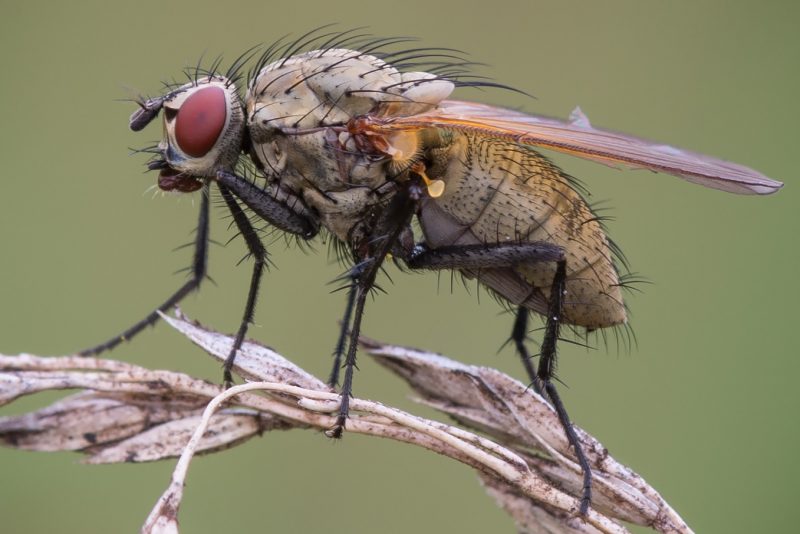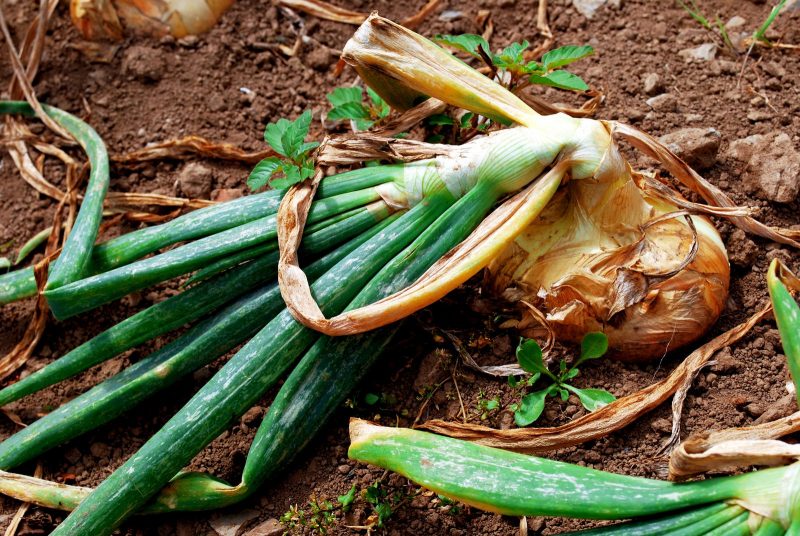Many gardeners and gardeners are interested in how to deal with onion flies. This pest is equally dangerous for flowers and vegetables, and can cause significant damage. Today, various insect control methods are known.
Material Content:
Signs of Onion Flies
A fly damages both plants that grow in open ground and greenhouse plants. Insects penetrate greenhouses through the smallest gaps, which practically does not protect plants from them.

The main signs that the onion fly appeared:
- small holes in the leaves of plants;
- rapidly increasing growth retardation of bulbs with quality care for them;
- too early yellowing of onion feathers and aerial parts of other plants, including bulbous flowers;
- twisting of leaves and their subsequent withering;
- dead dry plants are pulled effortlessly out of the ground with their hands.
Finally confirms the presence of the pest inspection of damaged plants. Cutting a sick bulb, you can see white worms, fly larvae. Their presence is 100% confirms the presence of a harmful insect.
How to deal with agricultural techniques?
There are a number of agrotechnical methods that can prevent damage to the plant by the pest. First of all, only high-quality material should be used for planting. If onion sets or bulbs of flowering plants are in doubt, they must be processed before planting in the ground.

- Treatment with warm water. Before planting sowing in the beds, it is necessary to soak it for 10 minutes in water heated to a temperature of +45 degrees. If you heat water to +50 degrees, then you need to keep planting material in it for no more than 5 minutes. After drying the bulbs for 15 minutes, they are planted.
- Manganese solution also protects plants from pests. Bulbs are placed in an intense pink solution for 5 minutes. After it is useful for them to shed a bed.
- Salting the soil. The onion fly does not tolerate salt, and therefore, if you lightly spray the bed before planting with strong saline, the larvae of the pest that may be in the ground will die.
- Planting next to onions a lovage or a tomato scares off a pest that does not tolerate their smell.
There is also a way to get rid of two pests at once - carrot and onion flies. To do this, it is enough to plant onions and carrots nearby, so the smell of one plant scares off the pest of another.
Folk remedies for the fight
Folk remedies for pest control can be used if the damage to the plants is not very strong and not massive. With a special abundance of onion flies, it is possible to cope with it only with the help of chemicals.
- Infusion of dandelions. This tool does not destroy the onion fly and its larvae, but effectively scares them away. To prepare the composition, grind 200 g of plant roots and, pour 10 l of water, insist 7 days. Pour onion infusion every 2 weeks. The first treatment is carried out 10 days after planting. It is necessary to have time to apply the remedy before the fly flies.
- The infusion of tobacco. For such a popular insecticide, you need to take 200 g of tobacco dust, pour 10 l of boiling water, and then add 30 g of soap (liquid) to the composition. Infused for 4 days, the composition is sprayed with onion plantings. It is also beneficial to sprinkle tobacco dust and earth for maximum effectiveness.
- Saline solution. As soon as the onion shoots grow to a height of 10 cm, they must be shed with a solution of sodium chloride, prepared at the rate of 300 g per 10 liters of water. After watering, the feathers of the culture should be washed with clean water so that the salt does not burn them. After 2 weeks, watering is repeated, but increasing the amount of salt to 450 g. After processing, the bed should be shed with clean water after 4 hours.
All folk remedies can only reduce the number of bulb flies and their larvae, but not completely destroy the pest. Because of this, with a large accumulation of flies, when it affects all onion plantings, the use of chemicals to destroy is required. However, due to the toxicity of the drugs, caution must be exercised when working with them.
Pest Chemicals
Due to the fact that onions tend to accumulate toxins in themselves, the use of chemicals when growing plants is highly undesirable. However, sometimes it is impossible to do without them, since there are too many pests and the lack of processing will lead to the complete death of the crop.

- Sublimate. To prepare a composition that will be effective against a pest and at the same time safe for humans, the product dissolves in a ratio of 1: 1500. Onion processing should be carried out until mid-May, since at a later date there is a high risk that the plant will accumulate too much chemical in the forming bulb.
- The use of insecticides directed action. The main of these funds are Aktara, Tabazol and Sochva. They should be used when 3 to 4 larvae or eggs of the pest are produced per plant. Using these tools, you must strictly follow the instructions for use, so that in the future when using onions do not get poisoning.
- Spraying with Intavir. To prepare the composition ¼ tablets are dissolved in 2 liters of water. 3 drops of glycerol or 1 teaspoon of liquid soap are also added to the solution. This is necessary to give the tool the necessary stickiness.

There is a sale of the drug "Flies", which is introduced into the soil at the time of planting.
Insecticides can destroy the insect, which is important to prevent further damage to the onion and its damage. However, it is worth starting not with them, but with safe alternative methods and only with their inefficiency switch to chemical preparations.
How to deal with onion fly larvae?
When buying dubious planting material, it is highly likely that it is already infected with onion fly larvae. They can also be present in the soil and attack the bulbs after planting. In such a situation, scaring away adults of the pest, the gardener still faces the problem of damage to the plantings. In order for the larvae not to destroy the onion, you need to know how to get rid of them.

All planting material before planting should be sorted out and destroyed bulbs that have foci of rot or not healthy appearance. They can not be thrown into the garden, but should be burned or disposed of with household waste.
The site, which is reserved for planting onions, must be prepared in the fall. It must be dug to a depth of 25 cm or even slightly deeper. This allows the soil to freeze well in the winter, from which the pupae of the fly and larvae will die and in the spring will no longer harm plantings.
Prevention of occurrence
To prevent the appearance of onion flies, certain preventive measures should be followed.

The main ones are:
- regular crop rotation;
- annual change of place for the onion beds;
- Autumn digging of the garden;
- destruction of all plant residues after harvest, so that pests do not winter in them.
When an onion fly is found in the garden, it is urgent to start fighting it. If this is not done, active reproduction of pests will begin; and soon the defeat of plants with the onion fly from the local one will become massive, and then it will be really difficult to rid the garden of the insect.












